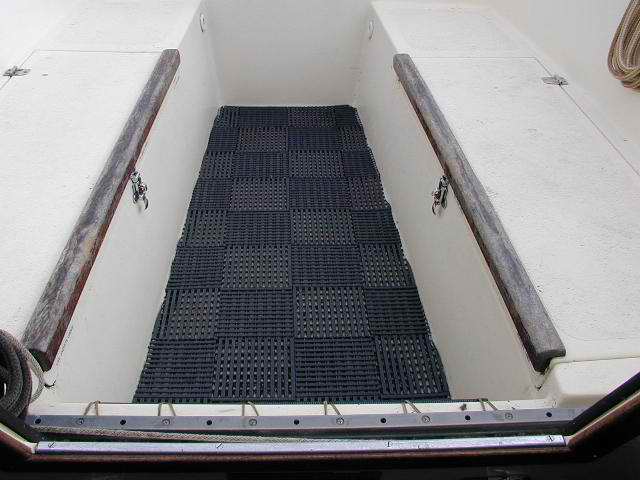| SJ23 Tech Tip B13, (Updated 2004-12-14) Bob Schimmel | |
|
Cockpit Grate or "Cleanliness is Next to Godliness." |
|
|
It is next to impossible to clean your shoes well enough to maintain a pristine deck. You'll know exactly what I'm talking about if you have to launch your dinghy from the beach, having walked over dirt or gravel to get to that beach. A cockpit grate is the last defence to trap shoe dirt, although I have dipped my shoe soles in the lake many times before climbing aboard! Cleanliness is one of those things I envy if you have a paved parking lot or are tied to a dock. The cockpit grate doesn't work 100% but it is better than nothing. Another advantage of a cockpit grate is improved traction when the boat is heeled at 200 in the rain! Wow what an improvement over standing on the wet gel coat on the cockpit sole. As nice as a custom wood grate would be, I choose to buy interlocking vinyl matting because the price, colour, stiffness, thickness and drainage are perfect. This product is sold under different names. EnviroTile, manufactured in Canada by IPEX, advertise it as an anti-slip, anti-skid and anti-fatigue, shower mat. Exactly the properties required on a sailboat. Best of all, the manufacturer uses recycled vinyl. Polymax makes the same grate in sheet which might be better in the cockpit. Choose a light colour so your feet don't cook when the stuff is exposed to the hot sun. My colour actually gets too hot after the sun beats on it all day. But it is nice in the Spring and Fall. While the mat is stiff enough to withstand 200 heel with one person bracing their feet, it is not quite stiff enough when the boat is heeled at 300 and beyond. At this angle the mat tends to slide across the cockpit and buckle under my feet. This is about the only disadvantage of this material. I have learned to live with it but guest crews are sometimes surprised by the curl of mat under their feet. A second crew will usually cause the mat to curl at 200. But then an SJ23 shouldn't be heeled beyond 200 anyway!
Make a template from cardboard using the following dimensions:
It will ensure that you draw an accurate outline of the cockpit floor along the centre line of the vinyl mat. It will also save you many trips up and down the ladder. Cut the template so it fits snug to the cockpit walls to ensure the mat does not slide when the boat is heeled. There is nothing more annoying than standing on a sliding mat. Use a very sharp stubby blade or a band saw to cut the vinyl material, creating a sloped edge that allows for the turn of the cockpit floor through the thickness of the mat. This way the top of the mat will lie snug against the wall creating a neat appearance. Once the template fits, draw a heavy line down the center of it for aligning the centerline to the vinyl mat. All corners are 1" radius. Use a hole saw to drill a 2" diameter hole through the grate, centered over each cockpit drain. Don't impede the flow. You may notice in the photo that the edges are stepped instead of smooth. This due to the shallow angle of the cockpit with respect to the straight lines in the mat. While I tried to straighten the edges by filling the voids with sealant, in the end I gave up as the matting worked perfectly fine. Not as neat looking as I would like but certainly simple and effective. After sailing several seasons with this mat in the cockpit, I am still very happy with the performance and my cabin floor stays cleaner. Now I just have to sweep away the sand under the mat or wash it to the cockpit drains! It's amazing how much gets trapped there. Cleaning the mat is accomplished with a quick dip in the lake. I have never seen anything stick to it. NOTES
|
|
|
Return to Tech Tip Index. . . . . . . . . . . . . . . Have a Question? |
|
 CONSTRUCTION - The cockpit of an SJ23 is
tapered along its length which makes cutting a square "ready made" stiff vinyl mat
somewhat difficult to fit.
CONSTRUCTION - The cockpit of an SJ23 is
tapered along its length which makes cutting a square "ready made" stiff vinyl mat
somewhat difficult to fit.